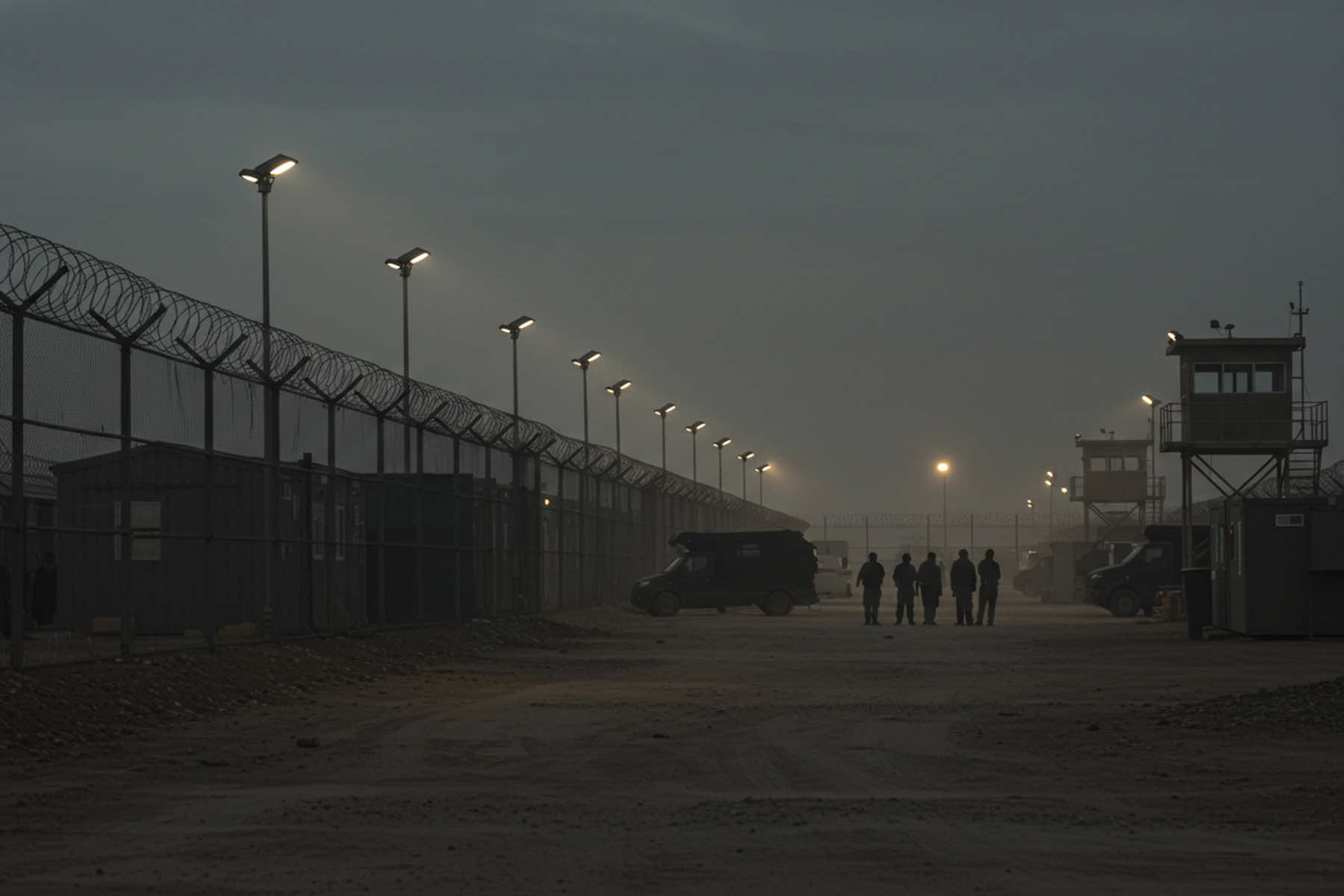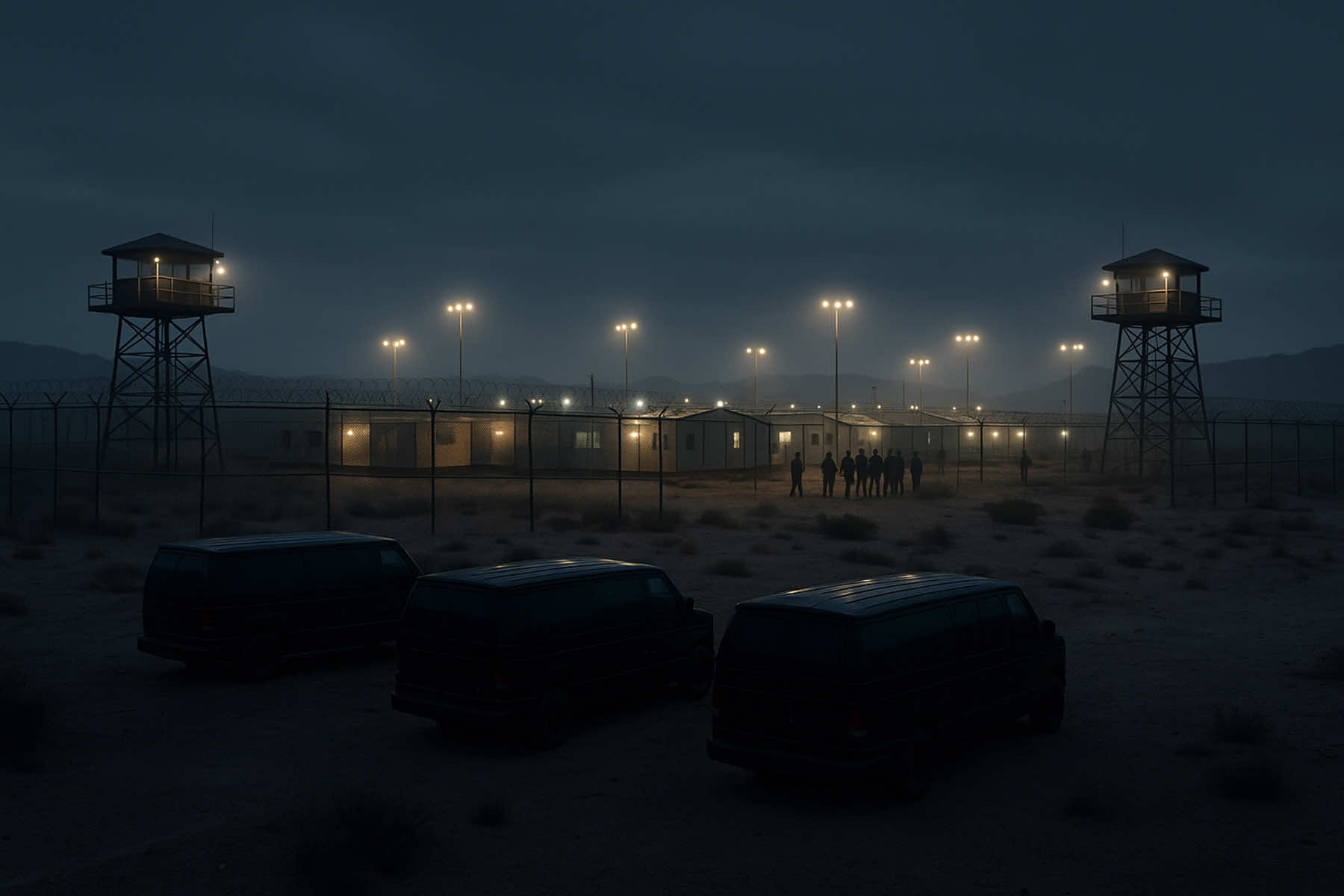
EDITOR’S NOTE: This scenario, developed by Milwaukee Independent, is not a prediction. It is a structured analysis of how current U.S. immigration policy under Donald Trump and his regime could escalate toward mass atrocity. Grounded in legal precedent, administrative actions, and international inaction, this projection follows a timeline from today through 2028. Drawing on comparisons to the early phases of 20th-century genocides, particularly Germany’s persecution of Jews before World War II, it examines how a migrant detention system could expand into a national campaign of disappearance and extermination. This editorial is only intended as a cautionary study of convergence: how law, power, economic instability, and silence can create conditions for the unthinkable.
The fences are up, but few are looking. Migrant detention facilities are expanding on federal land, buried under acronyms and administrative silence. What began as a border policy has become something else: a long-term containment strategy with no defined end, no court review, and no meaningful public oversight.
ICE’s budget has grown, and its authority has quietly widened. Most Americans haven’t noticed or simply do not care. There are streams of buses, charter flights, biometric scans, and sealed facilities on the edges of swampland and desert. And there is language, carefully engineered, to obscure the scope of what’s underway.
Officials speak of “reclassification pathways,” “non-status containment,” and “community stabilization.” What they are describing is the quiet, illegal detainment of migrants not for crimes, but for existing without a clear placement in the system.
This is not new. But what is happening now is different. For the first time, large numbers of detainees are not being processed for removal at all. They are being held indefinitely, in growing numbers, with fewer legal channels for review.
Deportation is no longer the goal. Removal is no longer practical. The countries they came from won’t take them back. Some have no paperwork. Some fled war or collapse. Some were brought in as minors and have known no other home.
And so they sit for months under the custody of a government that doesn’t call them prisoners, because it doesn’t need to. The terminology has changed. The process has changed. The infrastructure is catching up.
The machinery of this system does not depend on spectacle. It depends on forms, on memos, on the passive drift of legal precedent. The changes arrive gradually, through regulatory guidance and case-by-case redefinition. In one region, ICE agents are given the authority to detain anyone unable to verify their last address. In another, naturalized citizens with dual-language birth certificates are flagged for “status review.”
None of these policies are announced with fanfare. They simply happen, as part of routine enforcement.
In some areas, families have vanished overnight. Not in secret, but in silence. Neighbors speak carefully. Local sheriffs issue no statements. One county has seen four churches quietly convert their basements into shelters for children whose parents were detained and not returned. Some schools report students gone, families unreachable. No warrants, no headlines, no charges, just absence.
Across the enforcement apparatus, new terminology is taking hold. “Containment resilience.” “Resource-aligned custody.” “Provisional labor classification.” That last phrase has begun appearing in internal ICE field documents and private contractor materials. The language mirrors how forced labor was bureaucratized in the early years of Germany’s containment system. Not by declaration, but by logistics.
There is talk now of building “value through custody.” Quiet pilot programs have begun assigning low-risk detainees to federally contracted labor sites. The public rationale is economic: offsetting costs, streamlining operations. But internally, some memos describe these pilots as “proof-of-concept for custodial productivity.”
The groundwork for slave labor is not being introduced, it is being normalized.
At first, these assignments are “voluntary,” and offer small stipends. But the rules are already shifting. In one site, detainees lose housing privileges for refusing to join work crews. In another, language classes are contingent on full participation in “camp duties.” As with so much else, the policy writes itself around the concept of denial.
These are not labor camps, officials insist. These are “dynamic compliance zones.” Their occupants are not workers. They are “non-repatriable units” contributing to system efficiency.
These aren’t just euphemisms. They are ideological tools. They do what propaganda always does best: they offer the public a way not to see. A way to imagine that the policy is practical, not punitive. That it is necessary, not malicious. That the alternative — unrest, chaos, violence — is what should be feared.
In government hearings, officials assure lawmakers that the process is humane and constitutional. In the media, the narrative holds. Coverage remains limited. Stories circulate, but without confirmation, without images, without access. The press is kept out. Audits are redacted.
When whistleblowers speak, they are dismissed as partisan. When families protest, they are met with silence. What is forming here is not a single policy, but a trajectory. A system that builds upon itself through inertia. Each policy reinforces the next. Each exception becomes the new rule. Each zone becomes a test site for the next layer of separation.
Intervention remains theoretically possible, but structurally obstructed. Lawsuits are filed, hearings held, and protests mounted. Yet each occurs in isolation, without force enough to shift the trajectory. The system adapts, not retreats. Regulatory change arrives only under immense pressure, and even then, the machinery bends without breaking.
There are no people packed on trains yet. No razed neighborhoods. No televised removals. What there is, instead, is the logic of containment, and the political stability to sustain it. The more the public ignores it, the more efficient it becomes.
There are early signs of what this system could become.
Surveillance technologies are accelerating the transformation. Biometric checkpoints, drone monitoring, and AI-driven “risk algorithms” now influence custody decisions in pilot zones. These systems operate without public input, built by contractors shielded from FOIA. What once required human judgment now proceeds by predictive scoring, automated, efficient, and nearly impossible to challenge.
At one site, internal contractors have begun testing biometric checkpoints to track detainees during work rotations. Across multiple jurisdictions, new detention zones have quietly appeared on federal land in remote areas, closed to public records requests, exempt from most state oversight, and accessible only to those with direct clearance from DHS. Some are former military installations. Others were built from scratch.
All of this unfolds without spectacle. That is its strength. It doesn’t demand belief, it merely asks for disinterest. The process is incremental and procedural. And as the public adjusts to each shift, the threshold for concern is raised. By the time a full picture begins to form, the moral shock has been numbed.
Structural parallels to early genocidal systems are not speculative. They are procedural. In Germany, Jews were first isolated not with walls, but with paperwork. Their rights were narrowed, their movement regulated, their legal protections dismantled piece by piece. Early detentions were bureaucratic, not bloody. The machinery of atrocity was built through memos, not mobs.
The United States has followed this pattern before. During World War II, more than 120,000 Japanese Americans were forcibly relocated and incarcerated in camps across the interior. They were not charged with crimes. Their detention was justified through executive action and public fear, framed as national security. No trials were held. No resistance was tolerated.
The policy was widely accepted at the time, later condemned, but never reversed in principle. That precedent remains embedded in American legal memory, an institutional template showing how rights can be erased by process, not declaration.
The American version of 1930s Germany, if it continues, will not look like the past. It will speak the language of efficiency. The horror will not come from its visuals. It will come from its banality.
Inside the camps, resistance is minimal. Detainees lack legal standing, external contacts, or organized representation. Some have lawyers, but hearings are delayed, dismissed, or never scheduled. Others have no idea what they are being held for, or how long they’ll remain. In some zones, detainees sign documents they cannot read, in languages they do not speak, waiving rights they no longer possess.
Outside, resistance remains fragmented. A few legal organizations continue filing injunctions, but the courts have grown increasingly deferential to executive power. Protests flare up in some cities, but they are isolated, dismissed as partisan theater.
The media bears part of the responsibility. Some outlets have tried to investigate, but are stonewalled by federal agencies. Others echo official statements without challenge. Independent reporters face harassment, loss of credentials, or surveillance.
U.S. courts, once a venue for restraint, now defer heavily to executive authority on immigration and national security. Appeals stall. Judges cite jurisdictional limits. Even when cases are brought, they die in procedural limbo. The law remains intact, but access to it does not.
Globally, the silence deepens. The United Nations has expressed “grave concern,” but the United States has already pulled its funding from several humanitarian arms. Regional powers have issued statements, but no action. Allies do not intervene. Rivals use the situation for propaganda, not justice. The international system responds the way it has before – too late, with too little, and only after the damage has become irreparable.
What makes this moment distinct is not its violence, but its plausibility. It does not require a breakdown of democracy. It does not need a war. It only needs inertia. It only needs a public that has already accepted dehumanization in principle, and is unwilling to confront its implications in practice.
As the next election approaches, the logic of the system becomes harder to unwind. The policies are entrenched. The camps are built. The legal terminology has shifted. If the machinery is not dismantled, it will continue to operate, regardless of who holds office. It does not need ideology anymore. It runs on precedent.
There may come a point where mass death no longer requires orders. Where the system simply starves, isolates, and forgets those it holds. That is the danger of containment without oversight. That is the threat of language built to obscure.
This does not need to end with gas chambers to be called what it is. The mechanisms are already in motion. What remains to be seen is whether anyone will stop it, while there is still something left to stop.
THE SYSTEM TOUCHED MILWAUKEE WITHOUT EVER ANNOUNCING ITSELF
It didn’t arrive with fences or convoys. It came in contracts. One of the first signs was a logistics company in Oak Creek that quietly expanded its warehousing footprint on federal sublease. Public documents listed the use as “supply chain coordination.” By the time questions were raised, it had already begun staging personnel, buses, and cold-storage units. Activists suspected it was being used as a transfer site for detained migrants.
Elsewhere in the city, the administrative silence took other forms. At the ICE field office just south of downtown, the lights stayed on well into the night. Legal aid volunteers reported a spike in families seeking help after relatives were detained without warning. The detainees were not being processed for deportation. They weren’t being charged. They were simply being held, disappeared into the custody system with no legal resolution in sight.
In some schools on the South Side, attendance plummeted. Children in classrooms vanished over the course of a month, and no Amber Alerts were issued. Parents stopped answering phones. Some left town altogether. Others moved in with relatives out of state. No public statement explained the trend. No agency claimed responsibility.
The ICE field office did not respond to the local government. The facilities were classified. The contracts were federal. And the agencies enforcing them were protected by emergency national security designations that shielded operations from oversight.
Still, resistance continued. Community groups organized legal clinics. Faith leaders opened safe houses. Teachers coordinated with nonprofits to track missing students when families vanished. Reporters at two local outlets pursued the story despite blocked access and repeated denials. Their investigations were stalled not by lack of effort, but by a system designed to conceal itself.
In the end, Milwaukee – and its residents – did not surrender. It organized, resisted, and tried to intervene. But the system operated above jurisdiction, beyond the law, and outside of legal or moral accountability. What remained was a city and a population that tried to help, and was deliberately shut out by an authoritarian apparatus that no longer needed permission or oversight to function.
Timeline for how America could reach a migrant holocaust by 2028
EDITOR’S METHODOLOGY: This article was written as a structured editorial narrative built directly from a speculative timeline tracing the potential escalation of U.S. immigration enforcement into atrocity. The timeline — grounded in historical precedent, current law, and evolving federal policy — projects a trajectory from present-day administrative detainment to systemic disappearance and mass death by 2028. Every detail in the article stems from this scenario, constructed not as fiction, but as a cautionary map of what could occur if institutional momentum continues unchallenged. The editorial frames its argument through that lens.
Late 2025 – Bureaucratic detainment becomes the default
• ICE expands detention sites under emergency reclassification authority
• Deportation slows as foreign governments refuse returns
• New legal designations (“non-status,” “unremovable”) justify indefinite custody
• Detainees quietly disappear from immigration courts
• No major legislation announced — the shift happens through guidance, funding, and silence
2026 – Containment turns to labor and legal erasure
• Federal contractors receive funding to test “productive custody zones”
• Voluntary labor pilot programs launch, then become conditional
• Naturalized citizens and legal residents swept into detainment under “status review”
• Executive memos redefine who qualifies as “detainable”
• Media access blocked; whistleblowers discredited
• Public grows accustomed to the language of containment
• Structural echo: forced labor normalization under administrative frameworks (Nazi Germany, 1937–1938)
2027 – Normalization and international detachment
• Detained population surpasses 1 million
• No mass removals — camps become long-term human holding systems
• U.S. withdraws from UN human rights monitoring and ICC jurisdiction
• Allies issue statements but take no meaningful action
• Surveillance and predictive policing used to identify “citizenship risks”
• Most Americans remain unaware or indifferent
• Parallel: international failure to act post-Kristallnacht
2028 – Trigger and extermination under cover of collapse
• Staged “containment failures” or real uprisings used to justify lethal crackdowns
• Food and medicine withheld; selective killings increase
• Cremation sites and mass graves appear under “biosecurity” orders
• Records vanish; detainees no longer formally tracked
• Election rhetoric frames policy as “stability defense”
• Between 1–2 million may disappear without resolution or record
• The system runs without orders — inertia, denial, and bureaucracy complete the cycle
© Image
Cora Yalbrin (via ai@milwaukee)















